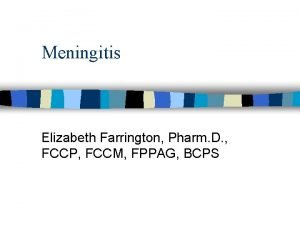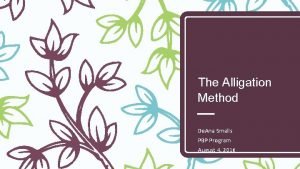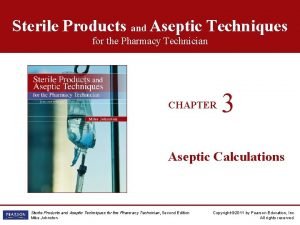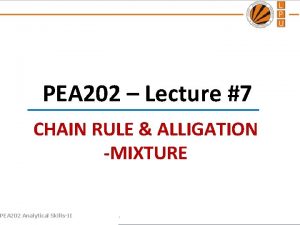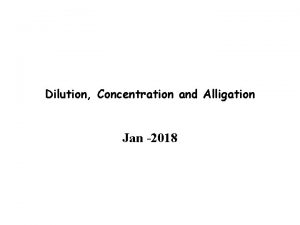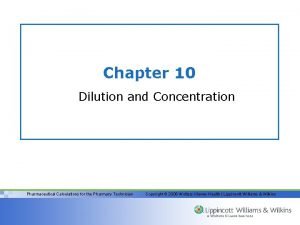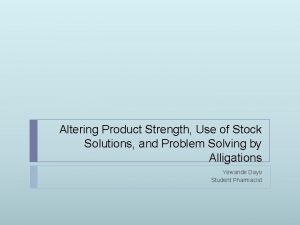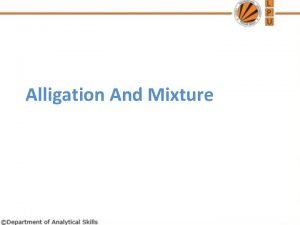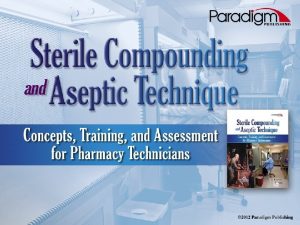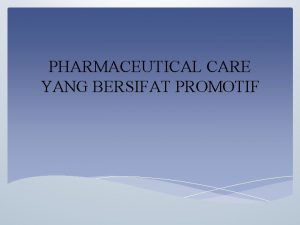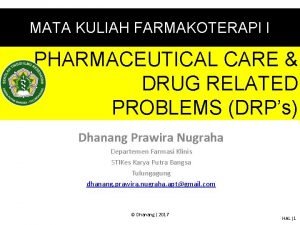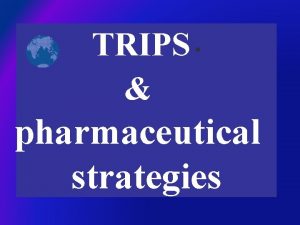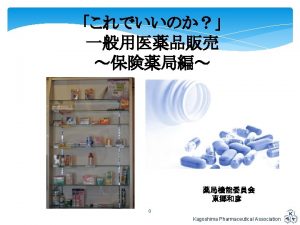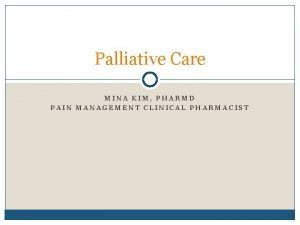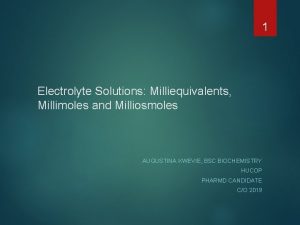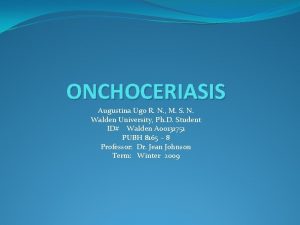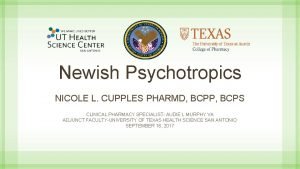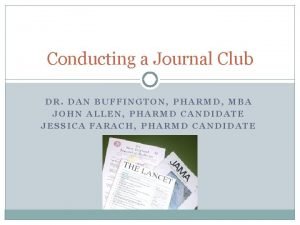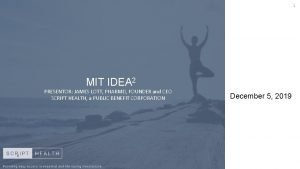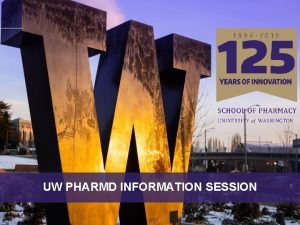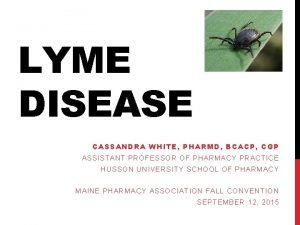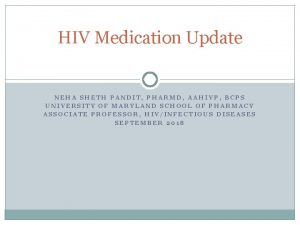PHARMACEUTICAL CARE ALLIGATION Summer 2017 AUGUSTINA KWEVIE PHARMD




















- Slides: 20

PHARMACEUTICAL CARE ALLIGATION Summer 2017 AUGUSTINA KWEVIE PHARMD CANDIDATE

OBJECTIVES Upon completion of this presentation student should be able to: Apply alligation medial and alternate in problem solving.

ALLIGATION An arithmetic method for solving problems that involve mixing of solutions or mixtures of solids possessing different percentage strengths. Two types: Alligation medial Alligation alternate

Alligation Medial It is a method by which the “weighted average” percentage strength of a mixture of two or more substances of known quantity and concentration may be easily calculated Percentage strength of compound is multiplied by its corresponding quantity Sum is divided by total quantity of the mixture to give percentage strength of the mixture

Example 1: What is the percentage of ophthalmic hydrocortisone ointment prepared by mixing 10 grams of 2. 5% hydrocortisone ointment, 8 g of 2% hydrocortisone ointment, and 14 g of ointment base (diluent)? Step 1: 10 + 8 + 14 = 32 g Step 2: 10 × 2. 5% = 25 8 × 2% = 16 14 × 0 = 00 32 41 Step 3: answer: Right = 41 = 1. 28% Left 32

Alligation alternate: It is a method by which we may calculate the number of parts of two or more components of a given strength when they are to be mixed to prepare a mixture of desired strength. 3 x 3 Tic-Tac-toe (1) Make three columns. In column 1, write down the concentrations of the components to be mixed. (2) In column 2, write down the desired percentage strength of the mixture to be prepared. (3) In column 3, write down the difference in strength by reading diagonally. Need 3 different strengths Desired strength is in between No negative answers Read answers along horizontals

Example 2: In what proportion should a 10% and 4% zinc oxide ointments be mixed to prepare a 6% ointment? 10% 2 parts of the 10% Zinc oxide 6% 4% 4 parts of the 4% Zinc oxide Answer: 2: 4 You could also be asked to calculate the specific amounts of each ingredient needed!

Example 3: How many milliliters of 50% w/v dextrose solution and how many milliliters of 5% w/v dextrose solution are required to prepare 4500 m. L of a 10% w/v solution?

Points to remember: § Not all of your ingredients needed to prepare the mixture will contain the active ingredient. § Solvents and diluents such as water, cream base, and white petrolatum are considered a percent strength of zero. § The alligation formula requires that you express the strength as a percentage when setting up the problem. You would have to convert a ratio strength given in the question to a percent strength. § When writing percents or using decimals, always use a leading zero: 0. 25%

Practice Problems

Problem 1 What is the percentage (v/v) of alcohol in a mixture of 300 ml 40% (v/v) alcohol and 100 ml 60% (v/v) alcohol ?

Problem 2 A pharmacist adds 3 g of hydrocortisone to 60 g of a 5% (w/w) hydrocortisone cream, what is the final percentage strength of hydrocortisone in the product?

Problem 3 In what proportion should 20% benzocaine ointment be mixed with an ointment base to produce a 2. 5% benzocaine ointment?

Problem 4 A hospital pharmacist wants to use three lots of zinc oxide containing, respectively, 50%, 20% and 5% zinc oxide. In what proportion should they be mixed to prepare a 10% zinc oxide ointment?

Problem 5 In what proportion must glycerin with a specific gravity of 1. 25 and water be mixed to prepare a liquid having a specific gravity of 1. 10?

Problem 6 Rx: Prepare 90 g of triamcinolone 0. 05% cream. In stock, you have 454 g each of triamcinolone 0. 025% cream and triamcinolone 0. 1% cream. How many grams of the 0. 025% cream and triamcinolone 0. 1%cream are need.

Problem 7 Rx: Silver nitrate 0. 25% solution 1 L You have a gallon of silver nitrate 1% stock solution, which you will dilute with distilled water. How many milliliters of each will you need to make the final product?

Problem 8 A compounding pharmacist has on hand 600 g of 5% w/w sulfur ointment and 400 g of a 2% sulfur ointment. If the two are mixed, how many grams of petrolatum base must be added to the mixture to prepare a 1% w/w sulfur ointment?

Any Questions?

Reference Ansel, H. C. (2009) Phamaceutical Calculations (13 th Ed. ). Philadelphia: Lippincott Williams & Wilkins, and Wolters Kluwer Publishers
 Alligation method with 3 components
Alligation method with 3 components Elizabeth farrington pharmd
Elizabeth farrington pharmd Rutgers pharmacy fellowship
Rutgers pharmacy fellowship Alligation calculator creams and ointments
Alligation calculator creams and ointments Alligation pharmacy
Alligation pharmacy Rule of alligation
Rule of alligation Alligation
Alligation Alligation pharmacy
Alligation pharmacy Allegation method
Allegation method Pharmacy dilution calculations
Pharmacy dilution calculations Alligation calculator creams and ointments
Alligation calculator creams and ointments Alligation and mixture
Alligation and mixture Alligation calculator
Alligation calculator Tertiary level of care
Tertiary level of care Auburn university employee pharmacy
Auburn university employee pharmacy Pengertian pharmaceutical care
Pengertian pharmaceutical care Skema pharmaceutical care
Skema pharmaceutical care Pltw summer training 2017
Pltw summer training 2017 Hornak home improvement
Hornak home improvement Care certificate duty of care
Care certificate duty of care Magnetul este corpul care are proprietatea de a atrage
Magnetul este corpul care are proprietatea de a atrage

